卫星通信关键技术研究讲解学习
深入解析人造卫星通信及数据传输的原理和方法

深入解析人造卫星通信及数据传输的原理和方法人造卫星通信技术是现代通信领域中的重要组成部分,它实现了远距离通信、广播、定位和数据传输等功能。
这些卫星通过无线电波传输信息,架起了遥远地区之间的通信桥梁。
本文将深入解析人造卫星通信及数据传输的原理和方法,以帮助读者更好地理解这一技术的工作原理。
首先,我们来了解人造卫星通信的原理。
人造卫星通信系统由地面站、卫星和用户终端组成。
地面站负责与用户终端进行通信,将信息传送给卫星;卫星则负责接收地面站发来的信号,并将其转发给指定的用户终端。
整个过程涉及到地面站与卫星之间的上行通信和卫星与用户终端之间的下行通信。
在卫星通信中,上行通信是指信息从地面站传输到卫星的方向。
这一过程中,地面站利用天线将信号发射出去,经过大气层的传播后,被接收并放大到足够的水平。
然后,卫星上的接收器接收到信号,并进行解调和处理,最后将信号转发到指定的用户终端。
下行通信则是相反的过程,即从卫星将信息传输到用户终端。
卫星上的发射器发射信号并经过大气层传播后,被用户终端接收并进行解调与处理。
为了实现可靠的通信,人造卫星通信通常采用的是射频通信技术。
射频通信技术指的是使用射频信号进行通信的技术。
通常,射频信号的频率范围为3kHz到300GHz,包括了无线电波、微波和毫米波等。
这种技术的优势在于可以在大范围内进行通信,并且具有较好的穿透能力和抗干扰能力。
在传输数据过程中,人造卫星通信通常采用数字信号传输。
数字信号是指用离散的数值来表示信息的信号。
通过将连续的模拟信号转换为离散的数字信号,可以增加存储和处理数据的能力,提高传输的准确性和可靠性。
数字信号传输通常采用调制与解调的方式进行,调制是将数字信号转换为模拟信号,而解调则是将模拟信号转换为数字信号。
在卫星通信中,常用的数字信号调制方式包括频移键控(FSK)、相移键控(PSK)、正交振幅调制(QAM)等。
其中,频移键控通过改变载波频率的方式来表示二进制数值;相移键控则通过改变载波相位的方式来表示二进制数值;正交振幅调制则通过改变载波的振幅和相位来表示多位二进制数值。
卫星通信:实现全球互联的关键技术!
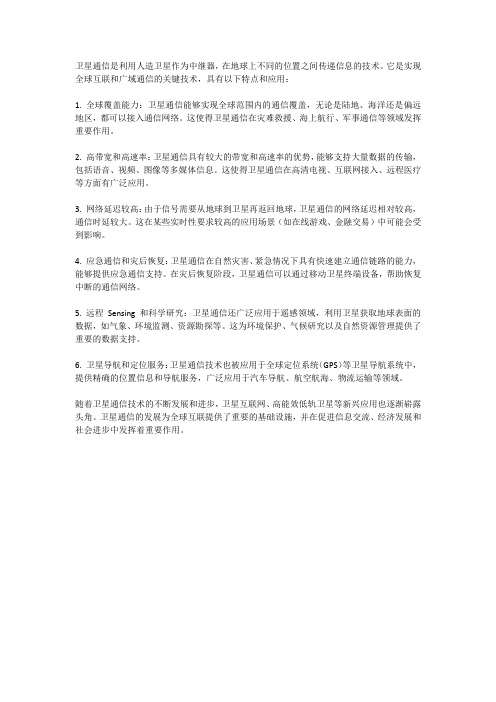
卫星通信是利用人造卫星作为中继器,在地球上不同的位置之间传递信息的技术。
它是实现全球互联和广域通信的关键技术,具有以下特点和应用:
1. 全球覆盖能力:卫星通信能够实现全球范围内的通信覆盖,无论是陆地、海洋还是偏远地区,都可以接入通信网络。
这使得卫星通信在灾难救援、海上航行、军事通信等领域发挥重要作用。
2. 高带宽和高速率:卫星通信具有较大的带宽和高速率的优势,能够支持大量数据的传输,包括语音、视频、图像等多媒体信息。
这使得卫星通信在高清电视、互联网接入、远程医疗等方面有广泛应用。
3. 网络延迟较高:由于信号需要从地球到卫星再返回地球,卫星通信的网络延迟相对较高,通信时延较大。
这在某些实时性要求较高的应用场景(如在线游戏、金融交易)中可能会受到影响。
4. 应急通信和灾后恢复:卫星通信在自然灾害、紧急情况下具有快速建立通信链路的能力,能够提供应急通信支持。
在灾后恢复阶段,卫星通信可以通过移动卫星终端设备,帮助恢复中断的通信网络。
5. 远程Sensing 和科学研究:卫星通信还广泛应用于遥感领域,利用卫星获取地球表面的数据,如气象、环境监测、资源勘探等。
这为环境保护、气候研究以及自然资源管理提供了重要的数据支持。
6. 卫星导航和定位服务:卫星通信技术也被应用于全球定位系统(GPS)等卫星导航系统中,提供精确的位置信息和导航服务,广泛应用于汽车导航、航空航海、物流运输等领域。
随着卫星通信技术的不断发展和进步,卫星互联网、高能效低轨卫星等新兴应用也逐渐崭露头角。
卫星通信的发展为全球互联提供了重要的基础设施,并在促进信息交流、经济发展和社会进步中发挥着重要作用。
谈卫星通信的发展趋势及其关键技术
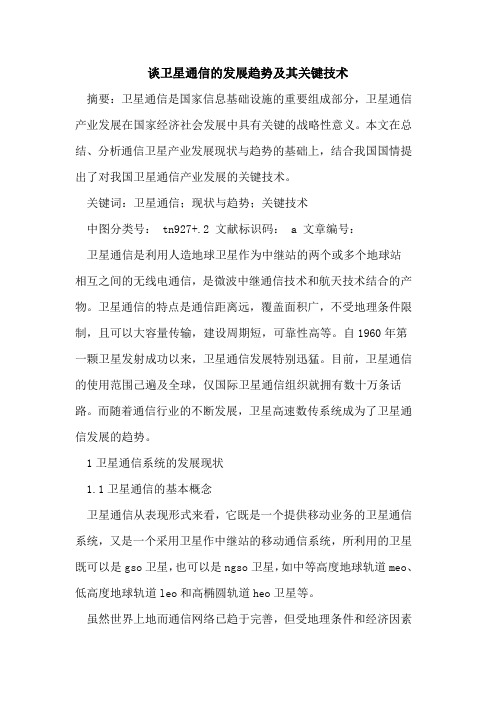
谈卫星通信的发展趋势及其关键技术摘要:卫星通信是国家信息基础设施的重要组成部分,卫星通信产业发展在国家经济社会发展中具有关键的战略性意义。
本文在总结、分析通信卫星产业发展现状与趋势的基础上,结合我国国情提出了对我国卫星通信产业发展的关键技术。
关键词:卫星通信;现状与趋势;关键技术中图分类号: tn927+.2 文献标识码: a 文章编号:卫星通信是利用人造地球卫星作为中继站的两个或多个地球站相互之间的无线电通信,是微波中继通信技术和航天技术结合的产物。
卫星通信的特点是通信距离远,覆盖面积广,不受地理条件限制,且可以大容量传输,建设周期短,可靠性高等。
自1960年第一颗卫星发射成功以来,卫星通信发展特别迅猛。
目前,卫星通信的使用范围己遍及全球,仅国际卫星通信组织就拥有数十万条话路。
而随着通信行业的不断发展,卫星高速数传系统成为了卫星通信发展的趋势。
1卫星通信系统的发展现状1.1卫星通信的基本概念卫星通信从表现形式来看,它既是一个提供移动业务的卫星通信系统,又是一个采用卫星作中继站的移动通信系统,所利用的卫星既可以是gso卫星,也可以是ngso卫星,如中等高度地球轨道meo、低高度地球轨道leo和高椭圆轨道heo卫星等。
虽然世界上地而通信网络已趋于完善,但受地理条件和经济因素的限制,地而蜂窝系统不可能达到全球无缝覆盖。
以我国为例,在偏远地区,地而网络的广泛覆盖仍然遥遥无期;在沿海岛屿众多的地方,建设地而网络非常困难;在发达地区的某些偏远地方同样没有地而蜂窝网的覆盖;野外勘探,飞机,远洋运输船只,远离城市的旅游探险者,以及紧急搜索、救援人员等都需要一种不受地域、天气限制的移动通信手段;西部地区疆域广阔,但多为荒漠和戈壁,人烟稀少,卫星通信将显示出独具的优势;尤其是发生重大毁灭性自然灾害的地区,地而网络多数会遭到破坏,而卫星通信可能是惟一幸存的通信手段。
所以,卫星通信是一种大有可为的通信方式,具有广阔的应用前景。
卫星通信中的信号传输技术和性能分析研究
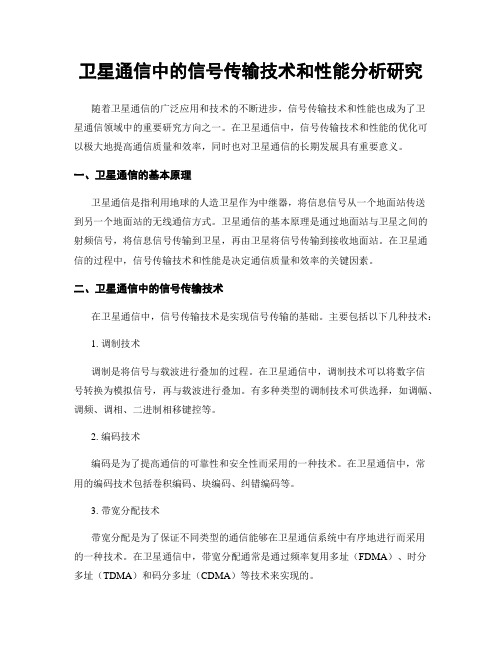
卫星通信中的信号传输技术和性能分析研究随着卫星通信的广泛应用和技术的不断进步,信号传输技术和性能也成为了卫星通信领域中的重要研究方向之一。
在卫星通信中,信号传输技术和性能的优化可以极大地提高通信质量和效率,同时也对卫星通信的长期发展具有重要意义。
一、卫星通信的基本原理卫星通信是指利用地球的人造卫星作为中继器,将信息信号从一个地面站传送到另一个地面站的无线通信方式。
卫星通信的基本原理是通过地面站与卫星之间的射频信号,将信息信号传输到卫星,再由卫星将信号传输到接收地面站。
在卫星通信的过程中,信号传输技术和性能是决定通信质量和效率的关键因素。
二、卫星通信中的信号传输技术在卫星通信中,信号传输技术是实现信号传输的基础。
主要包括以下几种技术:1. 调制技术调制是将信号与载波进行叠加的过程。
在卫星通信中,调制技术可以将数字信号转换为模拟信号,再与载波进行叠加。
有多种类型的调制技术可供选择,如调幅、调频、调相、二进制相移键控等。
2. 编码技术编码是为了提高通信的可靠性和安全性而采用的一种技术。
在卫星通信中,常用的编码技术包括卷积编码、块编码、纠错编码等。
3. 带宽分配技术带宽分配是为了保证不同类型的通信能够在卫星通信系统中有序地进行而采用的一种技术。
在卫星通信中,带宽分配通常是通过频率复用多址(FDMA)、时分多址(TDMA)和码分多址(CDMA)等技术来实现的。
三、卫星通信中的信号传输性能分析卫星通信中的信号传输性能是指卫星通信系统中各种信号传输技术所能实现的性能指标。
通过对信号传输性能的分析,可以评估通信质量和效率,提高卫星通信系统的整体性能和可靠性。
主要包括以下几个方面:1. 误码率误码率是指在信号传输过程中,接收端所接收到的数据比特中出现错误的比例。
误码率越低,表明通信质量越好,信号传输的可靠性越高。
2. 传输速率传输速率是指在单位时间内,能够传输的数据比特数。
传输速率越高,表明信息传输的效率越高,通信质量越好。
卫星通信系统中的信号调制与解调技术研究

卫星通信系统中的信号调制与解调技术研究卫星通信系统是现代通信领域中重要的技术手段,可以实现全球范围内的高质量通信。
信号调制与解调技术是卫星通信系统中必不可少的关键技术,它们的优化和研究对于提高通信系统的性能至关重要。
信号调制是将信息信号转换为适合在通信信道上传输的调制信号的过程。
在卫星通信系统中,信号调制技术旨在将信息信号转换成频率偏移、相位变化或振幅调整等特性的调制信号。
常见的调制技术包括幅度调制(AM)、频率调制(FM)和相位调制(PM)。
这些调制技术中,相位调制被广泛应用于卫星通信系统中,因为相位调制可以提供更高的频谱效率和抗干扰性能。
在相位调制中,常见的调制方式包括二进制相移键控(BPSK)、四进制相移键控(QPSK)和多进制相移键控(M-PSK)。
BPSK适用于二进制信号的调制,每个符号携带一个比特;QPSK适用于四进制信号的调制,每个符号携带两个比特;而M-PSK适用于多进制信号的调制,每个符号携带log2(M)个比特。
这些相位调制技术在卫星通信系统中根据需求灵活选择,以满足不同的传输需求。
信号调制后,卫星通信系统需要利用解调技术将调制信号转换为原始信息信号。
解调技术的目标是从接收端接收到的信号中恢复出原始信息信号。
在相位调制中,解调器通常利用相位差解调的原理来实现解调。
相位差解调通过比较接收到的信号与本地参考信号之间的相位差来恢复原始信息信号。
这种解调技术简单有效,能够在噪声环境中抑制多径干扰,并保持较好的误码率性能。
除了相位调制和解调技术,卫星通信系统中还应用了其他调制解调技术,如频率调制解调技术和幅度调制解调技术。
频率调制主要包括频移键控(FSK)和最小频移键控(MSK)。
频移键控通过改变载波的频率来传输信息,适用于低速数据传输。
最小频移键控则通过调整载波的频移与信号的变化率相匹配,以减小频谱带宽,提高频谱利用效率。
幅度调制主要应用于高速数据传输,常见的幅度调制技术有振幅移键控(ASK)和四相振幅移键控(QAM)。
卫星通信学习稿

非同步卫星
非同步卫星的运行周期不等于(通常小于)地球自转周期,其轨道倾角、轨道高度、 轨道形状(圆形或椭圆形)可因需要而不同。从地球上看,这种卫星以一定的速度在 运动,故又称为移动卫星或运动卫星。
概念
道 轨
通信卫星1
止
地球
静
极
通信卫星3
通信卫星2
不同类型的卫星有不同的特点和用途。在卫星通信中,同步卫星使用得最为广泛,其主要原 因是:第一,同步卫星距地面高达35800km,一颗卫星的覆盖区(从卫星上能“看到”的 地球区域)可达地球总面积的40%左右,地面最大跨距可达18000km。因此只需三颗卫星
中国卫星通信集团公司 鑫诺卫星通信有限公司 上海卫星通信公司 万康通信网络技术公司 中国电子科技集团公司第十四研 究所
北京中交星网宽频网络服务有限公司 北京百年兴业卫星通讯科技有限公司 北京东泽勤争科技开发有限公司 北京北电科林电子有限公司 北京迅达多维通信科技有限公司
国防科工局 研讨“一带一路”空间信息走廊建设和应用工程总体方案和工作方案。 国务院 《中国制造2025》发展新型卫星等空间平台与有效载荷、空天地宽带互联网系统,形 成长期持续稳定的卫星遥感、通信、导航等空间信息服务能力。 2013/01/09 发改委财政 《组织实施卫星及应用产业发展专项的补充通知》重点支持Ka波段宽带多媒体通信卫 部办公厅 星研制、S频段卫星移动通信民用地面系统关键设备研制及运动平台卫星通信应用系统 研发,推动卫星通信在公共教育、专业培训、医疗卫生、交通运输等领域的应用。 2013/01/16 中国民用航 《航空公司运行控制卫星通信应用政策》,要求在2017年底前实现所有运输类飞机使 空局 用卫星通信系统与运行控制中心在4分钟内建立语音通信联系的目标。 2012/04 发改委 《组织实施卫星及应用产业发展专项的通知》为拓展卫星通信的市场应用,填补卫星通 信服务领域的空白。 2015/05 2015/05
卫星通信系统与卫星通信技术分析

卫星通信系统与卫星通信技术分析随着科技的不断发展,卫星通信系统在现代社会中扮演着越来越重要的角色。
它通过卫星与地面站之间的通信,实现了全球范围内的信息传输和通信服务。
卫星通信系统的普及不仅带来了便利和高效的通讯服务,也在地面通信无法覆盖的区域提供了重要的通讯支持。
本文将对卫星通信系统及其相关技术进行深入分析。
一、卫星通信系统卫星通信系统是通过卫星与地面站之间的通信连接,实现信息传输和通信服务的系统。
通常包括卫星、地面站和用户终端等部分。
卫星通信系统的关键技术包括发射、传输、接收和处理等环节,每一个环节都需要高精度的技术支持。
1. 卫星卫星是卫星通信系统的核心组成部分,一般由发射天线、载荷、动力系统、存储系统等部分组成。
载荷是卫星传输信息的关键部分,它包括了信号的发射和接收器、天线等设备。
通过载荷系统,卫星能够实现信息的接收和发送,并将其传输到地面站或用户终端。
2. 地面站地面站是卫星通信系统的另一个重要组成部分,它用于与卫星进行双向通信。
地面站由天线、发射接收设备、信号处理设备等部分组成。
当地面用户需要进行通信时,地面站通过发射天线向卫星发送信号,并通过接收天线接收卫星传输的信号,完成信息交换的过程。
3. 用户终端用户终端是卫星通信系统中的最终用户设备,它通过卫星进行通信和信息传输。
用户终端通常包括卫星电话、卫星电视接收器、卫星定位接收器等设备。
用户终端设备通过接收卫星传输的信号,实现了通信、定位、导航和信息接收等功能。
卫星通信技术是支撑卫星通信系统实现通信和信息传输的关键技术。
它主要涉及到卫星发射接收、信号处理、频谱管理等方面的技术。
1. 频率与频率复用在卫星通信系统中,频率是信息传输的关键要素。
卫星通信用户使用的频率是有限的,为了提高频谱资源的利用率,需要采用频率复用技术。
频率复用技术能够实现多个用户共享同一频谱资源,通过不同的调制方案或多址接入技术,使得不同用户之间的信号不会互相干扰,从而实现了频谱资源的有效利用。
第三章《卫星通信》卫星通信的关键技术
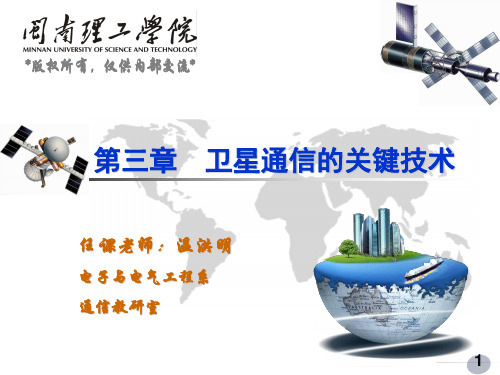
数字式时分话音内插系统原理图
28
卫
星
通
信
3.3.1 数字话音内插技术(DSI)
4、数字话音时分内插的工作过程
在发送端,话音检测器依次对各输入话路的工作状态加以识别, 判断它们是否有语音信号通过。
分配信息的传送方式有两种,一种是只发送最新的状态连接信息; 另一种是发送全部连接状态信息。 话路质量不变的情况下,使用m 条话路为n路服务(n>m),则有:
星
通
信
3.2.2 跟踪接收机
跟踪接收机的主要任务是把天线接收来的微波信号(信标信号、 导频信号、误差信号)进行放大,并把他的幅度变换为直流信号,直 流信号的大小对应于微波信号的强弱。
1、信标信号跟踪
信标信号频率高,需要独立的下变频器,,用专门的跟踪接收机 接收信标信号,适用于所有典型的地球站。
2、导频信号跟踪
星的信息:方位和俯仰角误差,并能驱动伺服系统使天线迅速对准卫星。 根据方式不同,可以分为多喇叭跟踪和多模跟踪两种。
等信号法
在偏离天线轴线的方向,寻找两个或者四个对称的点,然后比较 想过户对称点上得信号大小,并以此来判定目标偏离轴线的方向。
优缺点
跟踪精度和速度很高,但设备复杂,成本较高
17
卫
星
通
信
3.2.1 地球站天线跟踪系统体制
3、记忆极值式跟踪系统
记忆极值式跟踪系统与其他步进式跟踪的共同点就是把极大值 记忆下来与实时值进行比较,不同点是记忆极值式系统的电机是连 续转动的,也就是没有搜索步和调整步之分。 优点在于用一般的三相电动机,控制信号不用功率放大,对传 动系统要求也低。
18
卫
天线就是一种高频电波能量与高频信号功率间的换 能器,可以作为发射也可以作为接收。
卫星通信基础知识讲座-PPT课件

1、基本概念
1.4单跳、双跳
1、基本概念
1.5卫星通信频段
1) C波段,4/6GHZ 设备成熟,可用带宽500MHz,大部分国际卫星通信,尤其是 商业卫星通信都使用此频段,雨衰小,1-2dB C波段工作频段选择可以有以下选择:
1、基本概念
1.5卫星通信常用频段
1) C波段,4/6GHZ 扩展C特点:
1、基本概念
1.2通信卫星的类型
按高度分:
(1)低高度卫星,h<1500km; (2)中高度卫星,8000km<h<12000km; (3)高高度卫星,h>20000km。 范艾伦高速粒子带
1、基本概念
1.2通信卫星的类型
同步卫星
1、基本概念
1.3日凌中断与星蚀
春分和秋分前后还存在星蚀(卫星进入地球的阴影区)和日凌中断(卫星 处于太阳和地球之间,受强大的太阳噪声影响而使通信中断)现象。
2、卫星通信系统
2.2 通信地球站 2.2.2 天线
主要技度
2、卫星通信系统
2.2 通信地球站 2.2.2 天线
2、卫星通信系统
2.2 通信地球站 2.2.3 功放
•行波管功放(TWTA) 微波电子管,大功率(400W以上),线性差,寿命6~10年,便宜。 •固态功放(SSPA、SSPB)
砷化镓场效应管,中小功率,线性好,寿命10年以上,贵。
2、卫星通信系统
2.2 通信地球站 2.2.4 低噪声放大器(LNA、LNB)
•微波信号低噪声放大 •带下变频(LNB)或不带(LNA) •带10MHz参考输入或不带 主要指标: •工作频率
双 工 器 天 线
收中频
下变频
LNA
供电
卫星通信抗干扰体制及关键技术研究

Ab s t r a c t T h i s r e s e a r c h b a c k g r o u n d i s h o w t o i mp r o v e t h e a n t i - j a mmi n g a b i l i t y o f s a t e l l i t e c o mmu n i c a t i o n . Th r o u g h t h e i n t r o d u c t i o n o f
夫 董
鑫
葫芦岛 1 2 5 0 0 0 )
葫芦岛 1 2 5 0 0 0 ) ( 2 . 葫芦岛市森林 资源保护局
论文以如何提高卫星通信抗干扰 能力为研究背景 , 通过对卫星通信技术发展现状 的介绍 , 研究了卫 星通信抗干扰体制问题 , 并
提出技术上以扩谱技术为主 , 上行信 号为扩谱信号 , 下行信号 为 T D M 信号 , 信号的扩频过程 由地面站来完成等符合现阶段要求 的卫 星通信
t i o n s ,h a s mo r e s t r o n g e r a n t i - j a mmi n g ’ s a b i l i t y .I t p r o v i d e s t h e r e f e r e n c e me a n i n g f o r t h e r e s e a r c h i n g o f a n t i j a mmi n g a b i l i t y o f s a t e l l i t e c o n— r
卫星通信关键技术研究讲解学习

卫星通信关键技术研究卫星通信关键技术研究小组成员:冉文,李鹏翔,杨亚飞小组分工:冉文(学号:15085208210015):程序审查,论文校订李鹏翔(学号:15085208210008):收集资料,编辑文献,结果分析杨亚飞(学号:15085208210023):仿真程序设计专业:电子与通信工程引言卫星通信系统具有覆盖范围广、受地理环境因素影响小等特点,从而使得卫星通信成为当前通信领域中迅速发展的研宄方向和现代信息交换强有力的手段之一。
目前,下一代卫星通信网络正朝着更高速率、更大带宽的方向发展,其与地面通信网络联合组成全球无缝覆盖的信息交换网络。
随着空间通信技术的飞速发展和业务需求的急速增长,有限的无线资源与多媒体业务不断提高的QoS要求之间的矛盾曰益尖锐,使得设计可以支持高速、高质量多媒体传输的资源管理策略成为当前空间通信领域关注的重点。
同时,卫星组网技术直接关系到卫星网络能否实现全球覆盖以及卫星网络的可扩展性问题,是卫星通信系统研宂中的关键问题。
相应的,路由协议、链路切换等都要针对卫星网络的特点重新设计,以星上路由交换为核心的新型卫星通信系统是空间通信领域的另一个研究重点。
卫星通信是指利用人造地球卫星作为中继站转发无线电波,在两个或多个地球站之间进行的通信。
它是微波通信和航天技术基础上发展起来的一门新兴的无线通信技术,所使用的无线电波频率为微波频段(300MHz~300GHz,即波段lm~1min)。
这种利用人造地球卫星在地球站之间进行通信的通信系统,则称为卫星通信系统,而把用于现实通信目的的人造卫星称为通信卫星,其作用相当于离地面很高的中继站,因此,可以认为卫星通信是地面微波中继通信的继承和发展,是微波接力通向太空的延伸。
卫星通信是空间通信的一种形式,它主要包括卫星固定通信、卫星移动通信和卫星直接广播三大领域。
由于卫星通信具有覆盖面大、频带宽、容量大、适用于多种业务、性能稳定可靠、机动灵活、不受地理条件限制、成本与通信距离无关等优点。
卫星通信技术与应用研究
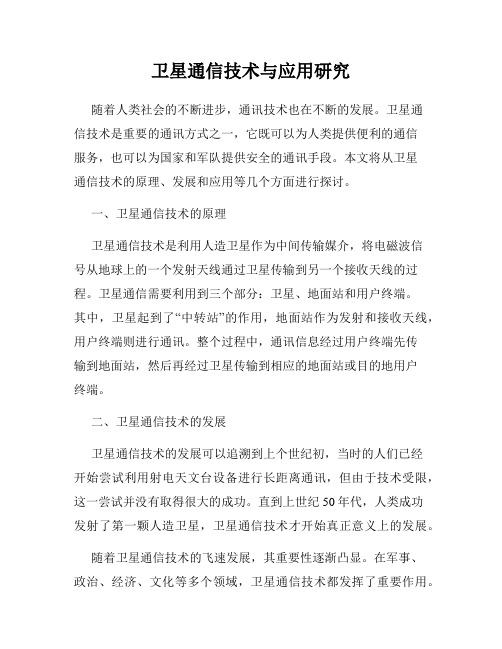
卫星通信技术与应用研究随着人类社会的不断进步,通讯技术也在不断的发展。
卫星通信技术是重要的通讯方式之一,它既可以为人类提供便利的通信服务,也可以为国家和军队提供安全的通讯手段。
本文将从卫星通信技术的原理、发展和应用等几个方面进行探讨。
一、卫星通信技术的原理卫星通信技术是利用人造卫星作为中间传输媒介,将电磁波信号从地球上的一个发射天线通过卫星传输到另一个接收天线的过程。
卫星通信需要利用到三个部分:卫星、地面站和用户终端。
其中,卫星起到了“中转站”的作用,地面站作为发射和接收天线,用户终端则进行通讯。
整个过程中,通讯信息经过用户终端先传输到地面站,然后再经过卫星传输到相应的地面站或目的地用户终端。
二、卫星通信技术的发展卫星通信技术的发展可以追溯到上个世纪初,当时的人们已经开始尝试利用射电天文台设备进行长距离通讯,但由于技术受限,这一尝试并没有取得很大的成功。
直到上世纪50年代,人类成功发射了第一颗人造卫星,卫星通信技术才开始真正意义上的发展。
随着卫星通信技术的飞速发展,其重要性逐渐凸显。
在军事、政治、经济、文化等多个领域,卫星通信技术都发挥了重要作用。
比如,在灾难救援中,利用卫星通信技术可以实现地震救援、空难救援以及海上搜救等工作,这极大提高了救援工作的精确度和速度。
三、卫星通信技术的应用随着科技的不断发展,卫星通信技术也在不断的发展和创新中。
现在卫星通信技术的应用已经覆盖了多个领域,如:1、通讯领域。
随着全球化的发展,人们之间的通讯也变得越来越频繁,卫星通信技术则可以为人们提供跨越地域、时空限制的全球通讯服务,如土星卫星电话等。
2、军事领域。
卫星通信技术可以为军队提供高度安全和可靠的通讯手段,可以用于联合作战、情报获取、情报传输等方面,以保障军事行动的成功执行。
3、气象预报领域。
卫星通信技术可以获取地球大气顶层信息,从而可以用于气象预报、气象监测、环境保护等方面,可以对天气预警进行精准预测。
4、航空航天领域。
卫星通信技术读书心得体会
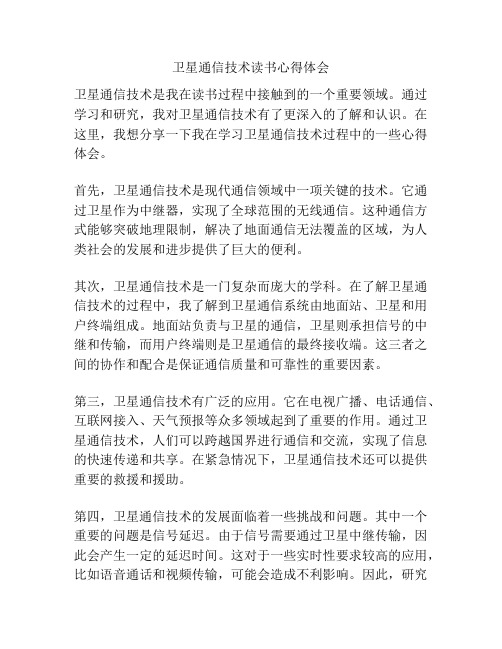
卫星通信技术读书心得体会卫星通信技术是我在读书过程中接触到的一个重要领域。
通过学习和研究,我对卫星通信技术有了更深入的了解和认识。
在这里,我想分享一下我在学习卫星通信技术过程中的一些心得体会。
首先,卫星通信技术是现代通信领域中一项关键的技术。
它通过卫星作为中继器,实现了全球范围的无线通信。
这种通信方式能够突破地理限制,解决了地面通信无法覆盖的区域,为人类社会的发展和进步提供了巨大的便利。
其次,卫星通信技术是一门复杂而庞大的学科。
在了解卫星通信技术的过程中,我了解到卫星通信系统由地面站、卫星和用户终端组成。
地面站负责与卫星的通信,卫星则承担信号的中继和传输,而用户终端则是卫星通信的最终接收端。
这三者之间的协作和配合是保证通信质量和可靠性的重要因素。
第三,卫星通信技术有广泛的应用。
它在电视广播、电话通信、互联网接入、天气预报等众多领域起到了重要的作用。
通过卫星通信技术,人们可以跨越国界进行通信和交流,实现了信息的快速传递和共享。
在紧急情况下,卫星通信技术还可以提供重要的救援和援助。
第四,卫星通信技术的发展面临着一些挑战和问题。
其中一个重要的问题是信号延迟。
由于信号需要通过卫星中继传输,因此会产生一定的延迟时间。
这对于一些实时性要求较高的应用,比如语音通话和视频传输,可能会造成不利影响。
因此,研究人员和工程师们一直在努力寻求解决方案,减少信号延迟。
另一个挑战是卫星通信系统的可靠性和安全性。
卫星通信系统所涉及的信息传输往往是敏感和机密的,因此必须保证通信的安全和隐私。
此外,卫星通信系统还必须能够应对自然灾害和故障等突发情况,确保系统的可靠运行。
最后,学习卫星通信技术也让我认识到科技的不断进步和创新对社会的推动作用。
过去几十年来,卫星通信技术经历了持续的发展和改进,使得全球通信更加便捷和高效。
随着数字化时代的到来,卫星通信技术将继续发挥重要作用,推动科技和社会的进步。
总结起来,学习卫星通信技术是一个很有意义的过程。
天线在卫星通信中的关键技术

天线在卫星通信中的关键技术在当今的信息时代,卫星通信作为一种重要的通信手段,在全球范围内发挥着至关重要的作用。
无论是广播电视信号的传输、远程通信服务的提供,还是气象数据的收集与分发,都离不开卫星通信技术的支持。
而在卫星通信系统中,天线无疑是其中最为关键的组成部分之一。
天线,简单来说,就是用于发射和接收电磁波的装置。
在卫星通信中,天线的性能直接决定了通信的质量、覆盖范围以及数据传输的速率。
为了实现高效、稳定且可靠的卫星通信,研究和应用一系列先进的天线技术至关重要。
首先,波束成形技术是天线在卫星通信中的一项关键技术。
通过调整天线阵元的激励幅度和相位,可以实现波束的指向控制和形状调整。
这意味着可以将信号能量集中在特定的方向上,从而提高信号的强度和接收效果。
例如,在卫星与地面站之间的通信中,可以通过波束成形技术将波束指向地面站所在的位置,减少信号的散射和衰减,提高通信的可靠性和数据传输速率。
多波束天线技术也是卫星通信中的重要手段。
传统的单波束天线只能在一个方向上进行通信,而多波束天线可以同时形成多个波束,覆盖不同的区域。
这使得卫星能够同时与多个地面站进行通信,大大提高了卫星通信的容量和效率。
想象一下,一颗卫星可以同时为多个地区提供通信服务,这在应对日益增长的通信需求方面具有巨大的优势。
相控阵天线技术在卫星通信中也有着广泛的应用。
相控阵天线通过控制阵列中各个单元的相位,可以快速地改变波束的指向,实现对目标的跟踪和通信。
这种快速响应的能力对于移动卫星通信,如飞机、船舶等交通工具上的通信,尤为重要。
它能够确保通信链路的稳定连接,不受载体运动的影响。
此外,自适应天线技术能够根据通信环境的变化自动调整天线的参数,以优化通信性能。
比如,当存在干扰信号时,自适应天线可以通过调整波束的方向和形状,降低干扰的影响,提高信号的信噪比。
这就像是天线有了“自我调节”的能力,能够适应各种复杂的通信场景。
天线的极化方式也是一个关键因素。
卫星互联网和5G通信融合关键技术研究_1

卫星互联网和5G通信融合关键技术研究发布时间:2022-06-08T07:46:11.030Z 来源:《中国科技信息》2022年第4期作者:姚劲松[导读] 现如今,5G已经进入商用时代。
在这一背景下,姚劲松中国电子科技集团新一代移动通信创新中心,上海, 200333摘要:现如今,5G已经进入商用时代。
在这一背景下,应当加大卫星通信、5G的融合研究,充分利用5G的优势促进卫星通信技术的发展。
文章就此展开了论述,先是简述了5G及星地融合通信的发展历史,接下来,分析了典型的地轨卫星通信系统,阐述了卫星通信与5G的融合途径,最后简述了其融合技术。
关键词:5G网络;卫星通信;发展;展望引言:全球无缝隙通信、超远距离通信、巨量设备并发通信是未来移动通信领域的研究热点,其将随着人类对空间的探索而逐渐扩展到太空高边疆、陆海远边疆以及物化虚边疆,带来人类生活和生产模式的根本性改变。
当前,我国移动通信正处于5G商用和6G技术研究阶段。
在6G时代,无线通信、有线通信、卫星互联网等将融合成一个整体,包括移动无线网、光纤骨干网、低轨道卫星在内的所有平台共同协作,来实现更有效、更高速、更安全、全方位的通信服务。
有专家直接提出5G 和卫星互联网融合就是6G的概念,由此可见5G网络和卫星互联网相互融合,共同发展已经成为不可阻挡的趋势。
1. 5G网络的概念及特点1.1 5G网络的概念5G网络是第五代通讯技术,理论传输速度可达每秒数十Gb。
据欧盟“构建2020年信息社会的无线移动通信领域关键技术(METIS)”项目称,5G是通过现有无线技术演进和开发补充性的新技术来构建长期的网络社会,通过集成多种无线接入技术,提供极限体验来满足用户的不同需求,是多种新型无线接入技术和现有无线接入技术集成后解决方案的总称,是真正意义上的融合网络。
1.2 5G网络的特点5G网络主要有三大特点,其一,极高的速率(eMMB):5G网络依靠4G的良好的技术构架,在此基础之上构建的新的技术,其目标是最大10Gbps。
《卫星通信技术》课件

卫星通信技术的应用领域将进一步拓展,如应急 通信、远程医疗、智慧城市等领域。
3
推动国际合作
卫星通信技术的发展需要国际合作,共同推进相 关技术和标准的发展,促进全球卫星通信产业的 繁荣。
05
结论
总结
卫星通信技术是现代通信领域的重要分支,具 有覆盖范围广、不受地面限制等优势,在军事 、民用等领域得到广泛应用。
发展,以满足日益增长的数据需求。
灵活的频谱利用
02
卫星通信将更加灵活地利用频谱资源,通过动态频谱分配和共
享技术提高频谱利用率。
高效的天线技术
03
天线技术的进步将有助于提高卫星通信系统的覆盖范围和数据
传输效率。
卫星通信技术的未来挑战
安全性问题
随着卫星通信的广泛应用 ,网络安全和隐私保护成 为重要挑战,需要加强安 全措施和技术研发。
《卫星通信技术》PPT 课件
目录 CONTENT
• 卫星通信技术概述 • 卫星通信系统组成 • 卫星通信技术的应用 • 卫星通信技术的未来发展 • 结论
01
卫星通信技术概述
卫星通信技术的定义
01
卫星通信技术是指利用人造地球 卫星作为中继站,实现地球站之 间的无线电通信。
02
卫星通信技术可以实现全球覆盖 、远距离传输和广播服务等功能 ,是现代通信技术的重要分支之 一。
数据传输。
加强卫星通信在偏远地区和 海洋等地的覆盖和应用,提 高信息传递的普及率和便捷
性。
加大对卫星通信技术研发的支 持力度,鼓励创新,突破关键
技术瓶颈。
对未来研究的展望
01
探索新型卫星通信体制和传输协议,提高数据传输 效率和可靠性。
02
移动卫星通信的关键技术
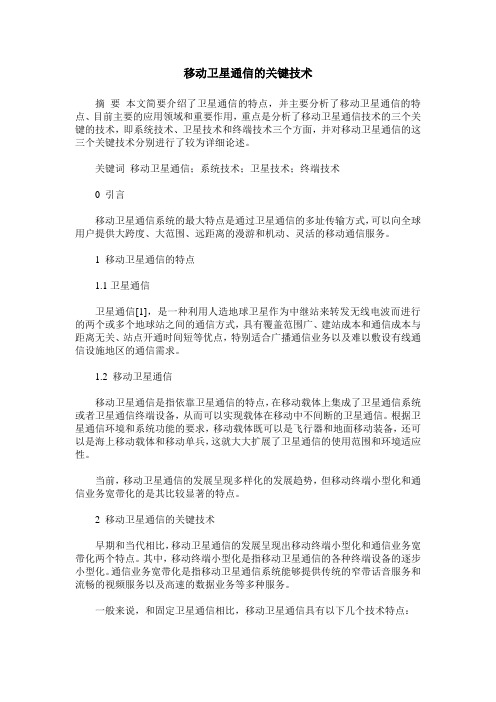
移动卫星通信的关键技术摘要本文简要介绍了卫星通信的特点,并主要分析了移动卫星通信的特点、目前主要的应用领域和重要作用,重点是分析了移动卫星通信技术的三个关键的技术,即系统技术、卫星技术和终端技术三个方面,并对移动卫星通信的这三个关键技术分别进行了较为详细论述。
关键词移动卫星通信;系统技术;卫星技术;终端技术0 引言移动卫星通信系统的最大特点是通过卫星通信的多址传输方式,可以向全球用户提供大跨度、大范围、远距离的漫游和机动、灵活的移动通信服务。
1 移动卫星通信的特点1.1卫星通信卫星通信[1],是一种利用人造地球卫星作为中继站来转发无线电波而进行的两个或多个地球站之间的通信方式,具有覆盖范围广、建站成本和通信成本与距离无关、站点开通时间短等优点,特别适合广播通信业务以及难以敷设有线通信设施地区的通信需求。
1.2 移动卫星通信移动卫星通信是指依靠卫星通信的特点,在移动载体上集成了卫星通信系统或者卫星通信终端设备,从而可以实现载体在移动中不间断的卫星通信。
根据卫星通信环境和系统功能的要求,移动载体既可以是飞行器和地面移动装备,还可以是海上移动载体和移动单兵,这就大大扩展了卫星通信的使用范围和环境适应性。
当前,移动卫星通信的发展呈现多样化的发展趋势,但移动终端小型化和通信业务宽带化的是其比较显著的特点。
2 移动卫星通信的关键技术早期和当代相比,移动卫星通信的发展呈现出移动终端小型化和通信业务宽带化两个特点。
其中,移动终端小型化是指移动卫星通信的各种终端设备的逐步小型化。
通信业务宽带化是指移动卫星通信系统能够提供传统的窄带话音服务和流畅的视频服务以及高速的数据业务等多种服务。
一般来说,和固定卫星通信相比,移动卫星通信具有以下几个技术特点:1)天线低增益与卫星功率的有限性之间存在突出矛盾;2)低增益天线存在多径效应和多普勒频移等传播信道问题;3)众多终端用户共享有限的功率资源和卫星频率;4)机动性、小型化和漫游管理等要求。
卫星通信抗干扰体制及关键技术探讨

力 。卫星通信技术 的大力发展 ,进一 步提 高了 行卫星信号 ,进而实施信号干扰 ,这成为 了未 来卫星通讯最有效 、最常用 的对抗通信方式 。 卫星通信的组网技术、系统容量与业务品质。
四,在 7 0赫兹 或 1 4 0赫兹 中频进行信 号扩谱 与信号解扩。选择 3 6赫 兹或 7 2赫兹 宽的转 发 器,可 以充分利用现 有器件 与技术。第五,现 阶段能够对 8 - l 6 路信号 同时进行研究与分析, 每路信 号速率可设置 为 4 . 8 k b i t / s ,. 9 . 6 k b i t / s 、 1 4 . 4 k b i t / s 、1 9 . 2 k b i t / s ,可随机 占用信 道也可按 申请分配信道 。第六 ,在选择频段上 ,需要考 虑向E H F段发展 。
研究卫星通信抗干扰体制,必须要找到与 星的通信吸 引力 。第三 ,多址方式 ,使得卫星 通信技术与未来发展技术更加吻合 。第 四,星 卫星通信特点相吻合 、抗干扰能力强 、能有效 上处理技术 , 使得 卫星通信 自身发生质 的变化 。 抵御各种人为干扰的抗干扰新技术 。站在通信 第五 ,交换体制与传输体制 的发展 ,大大提 高 了卫星通信 向综合业务过渡 的可能性 。第六 , 电子角度分析 ,卫星抗干扰主要 由跟踪瞄准干
扰、 宽带强功 率干扰 以及 同频 窄带干扰等技术 。
小型化 、轻型化与智 能化等技术 的发展 ,有 效 针对卫星通信来说,笔者认为要想实施干扰 , 解 决了动 中通等 问题 。第七 ,对 于卫星通 信频 必须在上行链路进行 ,综合考虑抗干扰效果 、 段与通信体制 的研 究,大大提 高了卫 星通信 活 经济因素 以及技术 因素 ,侦查 、测位与跟踪上
I J - - . : } I l - l l — 0 卅 粗_
- 1、下载文档前请自行甄别文档内容的完整性,平台不提供额外的编辑、内容补充、找答案等附加服务。
- 2、"仅部分预览"的文档,不可在线预览部分如存在完整性等问题,可反馈申请退款(可完整预览的文档不适用该条件!)。
- 3、如文档侵犯您的权益,请联系客服反馈,我们会尽快为您处理(人工客服工作时间:9:00-18:30)。
卫星通信关键技术研究卫星通信关键技术研究小组成员:冉文,李鹏翔,杨亚飞小组分工:冉文(学号:15085208210015):程序审查,论文校订李鹏翔(学号:15085208210008):收集资料,编辑文献,结果分析杨亚飞(学号:15085208210023):仿真程序设计专业:电子与通信工程引言卫星通信系统具有覆盖范围广、受地理环境因素影响小等特点,从而使得卫星通信成为当前通信领域中迅速发展的研宄方向和现代信息交换强有力的手段之一。
目前,下一代卫星通信网络正朝着更高速率、更大带宽的方向发展,其与地面通信网络联合组成全球无缝覆盖的信息交换网络。
随着空间通信技术的飞速发展和业务需求的急速增长,有限的无线资源与多媒体业务不断提高的QoS要求之间的矛盾曰益尖锐,使得设计可以支持高速、高质量多媒体传输的资源管理策略成为当前空间通信领域关注的重点。
同时,卫星组网技术直接关系到卫星网络能否实现全球覆盖以及卫星网络的可扩展性问题,是卫星通信系统研宂中的关键问题。
相应的,路由协议、链路切换等都要针对卫星网络的特点重新设计,以星上路由交换为核心的新型卫星通信系统是空间通信领域的另一个研究重点。
卫星通信是指利用人造地球卫星作为中继站转发无线电波,在两个或多个地球站之间进行的通信。
它是微波通信和航天技术基础上发展起来的一门新兴的无线通信技术,所使用的无线电波频率为微波频段(300MHz~300GHz,即波段lm~1min)。
这种利用人造地球卫星在地球站之间进行通信的通信系统,则称为卫星通信系统,而把用于现实通信目的的人造卫星称为通信卫星,其作用相当于离地面很高的中继站,因此,可以认为卫星通信是地面微波中继通信的继承和发展,是微波接力通向太空的延伸。
卫星通信是空间通信的一种形式,它主要包括卫星固定通信、卫星移动通信和卫星直接广播三大领域。
由于卫星通信具有覆盖面大、频带宽、容量大、适用于多种业务、性能稳定可靠、机动灵活、不受地理条件限制、成本与通信距离无关等优点。
多年来,它在国际通信、国内通信、军事通信、移动通信和广播电视等领域得到了广泛应用。
下面我们就从卫星通信的发展简史、现状、趋势等方面对卫星通信进行概括和综述。
摘要本文从分析卫星通信的特点入手,综述了卫星通信的主要相关技术的发展状况,概述了典型的卫星通信系统的性能特点并给出了卫星衰落信道的模型,进行了MATLAB仿真,介绍了卫星通信的应用及产业化发展情况,并展望了发展前景。
移动性管理是 LEO(低轨卫星(low earth orbit))卫星网络通信系统中的一个重要问题.提出了 LEO 网络中一种改进的基于移动的位置更新和寻呼方案.在这种方法中我们引入了“元小区”概念,它由两个相邻波束组成.首先阐述了基于“元小区”模型的位置管理策略,然后推导了基于移动的动态位置管理的数学模型,并利用该模型分别计算了 LEO 网络中单位呼叫的位置更新和寻呼代价.通过元小区方案和普通小区的在各种网络参数环境下的性能比较证明了“元小区”方法的有效性和健壮性.最后为了进一步减小“元小区”方法中的寻呼代价,提出了强制更新策略,它强制移动终端在穿越两颗卫星覆盖区的边界时进行位置更新操作.关键词:卫星通信;位置管理;终端寻呼;元小区;位置更新;移动卫星通信;星上处理;星上交换;多波束天线;蜂窝网卫星系统AbstractAfter analyzing the characteristics of satellite communications, the developing status of communication satellite platform, available frequency resource, as well as the related key techniques are summarized. Through introducing some typical satellite communications systems, were presented the applications and industrialization of satellite communications, and furthermore shows the bright prospects.Mobility management is an important aspect in LEO (low earth orbit) systems. In terrestrial wireless networks, the movement of the user triggers location updating and determines the paging scheme, while in LEO satellite systems, the location updating and paging is mainly based on the movement of satellite. Terrestrial location management techniques must be altered to fit the LEO systems. This paper introduces a modified movement-based location updating and paging scheme in LEO networks. In this scheme the meta-cell concept is proposed which includes two spot-beams of one satellite. First the location management scheme based on the architecture with meta-cell location area is presented. Then an analytical model is applied to formulate the cost of location updating and paging for the movement meta-cell based dynamic location updating scheme. The comparison of performance between the meta-cell architecture method and the conventional signal-spot-cell architecture method is provided to demonstratethe cost-effectiveness and robustness of the proposed scheme under various parameters. To reduce the impact of meta-cell architecture on the location paging cost, a forced location updating strategy is presented which is used in the cases that the meta-cell includes the two spot-beams from different satellites。
Key words: satellite communications; mobile satellite communications; onboard processing; onboard switching; multi-beam antenna; cellular satellite system目录第一章卫星通信综述 (1)第二章卫星通信若干关键技术及其发展现状 (3)2.1调制解调技术 (3)2.2纠错编码技术 (4)2.3扩频通信技术 (5)2.4阵列天线技术与卫星蜂窝网技术 (6)2.5多址和复用技术 (8)2.6空间激光通信技术 (10)第三章关键技术仿真及相关程序 (11)第四章卫星通信发展现状与展望 (14)4.1 发展现状 (14)4.2 卫星移动通信现状 (14)4.3 卫星直接广播现状 (16)4.4 卫星通信的发展趋势及我国卫星通信的发展目标 (17)4.5 发展展望 (19)结束语 (20)参考文献 (21)附录1 MATLAB 仿真程序 (22)第一章卫星通信综述1965 年美国发射第一颗商用通信卫星以来,卫星通信技术及其应用取得了令人瞩目的巨大成就。
它实现了覆盖全球丰富多彩的通信服务,不仅在军事中发挥了关键性作用,也对人类的生产、生活方式产生了巨大影响。
与微波中继通信及其他通信方式相比,卫星通信主要具有以下特点。
(1)通信覆盖区域大,通信距离远:地球同步轨道(GEO)卫星距地面高度 35 860 km,只需一个卫星中继转发,就能实现 1 万多公里的远距离通信;每一颗卫星可覆盖全球表面的 42.4%,用 3 颗 GEO 卫星就可以覆盖除两极纬度76°以上地区以外的全球表面及临地空间;如图 1 所示。
(2)可将其广播性与各种多址连接技术相结合构成庞大的通信网:在一颗卫星所覆盖的区域内,不必依赖显式的交换,只需利用卫星中继传输和多址/复用技术就能构成拥有许多地面用户的大型通信网。
(3)机动灵活:卫星通信的建立不受地理条件的限制,无论是大城市还是边远山区、岛屿,随地可建;通信终端也可由飞机、汽车、舰船搭载,甚至个人随身携带;建站迅速,组网灵活。
(4)通信频带宽、通信容量大:卫星通信信道处于微波频率范围,频率资源相当丰富,并可不断发展。
(5)信道质量好、传输性能稳定:卫星通信链路一般都是自由空间传播的视距通信,传输损耗很稳定而可准确预算,多径效应一般都可忽略不计,除非是采用很低增益天线的移动通信或个人通信终端。
(6)通信设备的成本不随通信距离增加而增加,因而特别适于远距离以及人类活动稀少地区的通信。
卫星通信也存在一些缺点和一些应该而且可以逐步改进的方面,这主要有以下几点。
1)卫星发射和星上通信载荷的成本高:星上元器件必须采用抗强辐射的宇航级器件,而且 LEO、 GEO 卫星的寿命一般分别只有 8 年、15 年左右。
2)卫星链路传输衰减很大:这就要求地面和星上的通信设备具有大功率发射机、高灵敏度接收机和高增益天线。
3) 卫星链路传输时延大:GEO 卫星与地面之间往返传输时间为 239~278 ms;在基于中心站的星形网系统中,小站之间进行话音通信必须经双跳链路,那么传输时延达到0.5 s,对话过程就会感到不顺畅,而且如果没有良好的回音抑制措施,就会因二-四线制转换引起的回波干扰而使话音质量显著下降。
